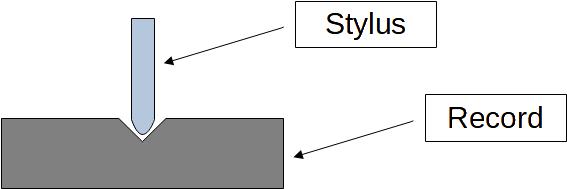Would you like to find out more about how a record works? We dive into how signals are stored, why we need RIAA equalization, discuss stereo vs. mono signals etc.

What is a record actually?
A record consists of a disk of hot-pressed plastic, the main component being polyvinyl chloride (hence the nickname vinyl). The plastic also contains PVA and other additives that improve the sound fidelity and longevity of the record. On each side of this record there is a groove running from the outside to the inside which holds the analogue signal. During playback, the stylus samples the information of the groove and the cartridge converts these vibrations into an electrical signal. This electrical signal is amplified by a suitable amplifier so that the loudspeaker can convert the electrical signal into an acoustic signal. To promote understanding of how a record works, I can highly recommend this awesome microscope footage.
The record player’s predecessor, the gramophone, had no electronics at all. It converted the stored signal on the record directly into an acoustic signal. This approach naturally imposed strict limits with regard to playback quality and, in particular, loudness.
How the sound comes onto the record
At the very beginning of the creation of a record, the acoustic signals have to somehow get into the groove. There are special cutting machines for this that basically do the same thing as the record player, just in reverse. They not only cut the bare groove, but also modulate the acoustic signal into the groove as a mechanical signal. There are service providers who have such machines and can cut a customized record for surprisingly little money. So when you get prototypes or small series as records, they are typically these so-called direct cuts. This process is of course somewhat unwieldy for series with large quantities. For this purpose, a master is first cut, a negative mold is made from it and the records are pressed from this mold. Nowadays, in the digital age, there are only a few dozen locations worldwide that press high-volume quantities using this process.
The duration of time a record can store depends largely on the diameter of the record. A typical 12 inch record can store about 22 minutes per side, giving a total of about ten to twelve tracks for both sides. A small 7 inch record offers space for around 5 minutes per side and therefore a total of two to three tracks.
Mastering HiFi: A matter of details
Now that we know how a record works in general, let’s take a look at the details.
The need for equalization
In the article about tracking force we learned that the tracking ability depends largely on the velocity of the stylus. The velocity, in turn, depends on the frequency and the amplitude (loudness). Have you ever looked at the diaphragms of your speakers at higher volume? Then you’ve probably noticed that the woofers vibrate noticeably, while you can’t actually see anything with the tweeters. The reason for this lies in the intensity of the individual frequency ranges. Bass requires a lot more energy than treble to produce the same perceived loudness.
In relation to the record, this of course means that the bass requires a lot of modulation of the groove, while the treble requires very little. If you would modulate all frequencies linearly into the groove, the stylus would not be able to track the high modulation of the bass and skip. On the other hand, it could only sample treble very weakly because they would almost disappear in the noise. To get around this problem, the audio signal is equalized in practice. When cutting, the bass is attenuated and the highs are amplified. In the history of records, the RIAA characteristic curve has ultimately prevailed. It defines the frequencies at which attenuation and amplification take place. When playing back, we have to reverse this characteristic in order to obtain a neutral audio signal.
A pinch of compression
To further increase the fidelity, the music is often compressed slightly. Admittedly, it is not essential for understanding how a record works. But while we’re at it, I’d like to at least mention it for the sake of completeness. Compression works similarly to equalization, only independent of frequency. Instead, quiet passages become louder and loud passages become slightly quieter. Technically speaking, we are reducing the dynamic range. With a compressed signal you can also reduce the spacing of the groove slightly because of the reduced modulation. That’s why the compressed signal not only sounds more beefy but also increases the length of music that fits on a record.
Two channels in one single groove
To modulate the two channels of a stereo signal in one single groove, the engineers back then came up with a quite sophisticated approach. With the mono records that were common up to that time, the signal was only modulated laterally. The obvious conclusion would have been to claim the depth as the next degree of freedom. To do this, you could modulate one channel in depth and the other channel laterally. But that would have meant that a stereo record would only have played one of the two channels on a mono record player. Obviously not a satisfactory solution.
Instead, the trick is to rotate the arrangement by 45°. The left and right channels are still perpendicular to each other, but both form a 45° angle to the record surface. The advantage: A mono cartridge, which can only sample lateral signals, gets half of each channel, so to speak. Pretty clever, right? The two coils of a stereo cartridge also form a 45° angle to the record surface and a 90° angle to each other. You can see this clearly in the illustrations in the article about cartridges.